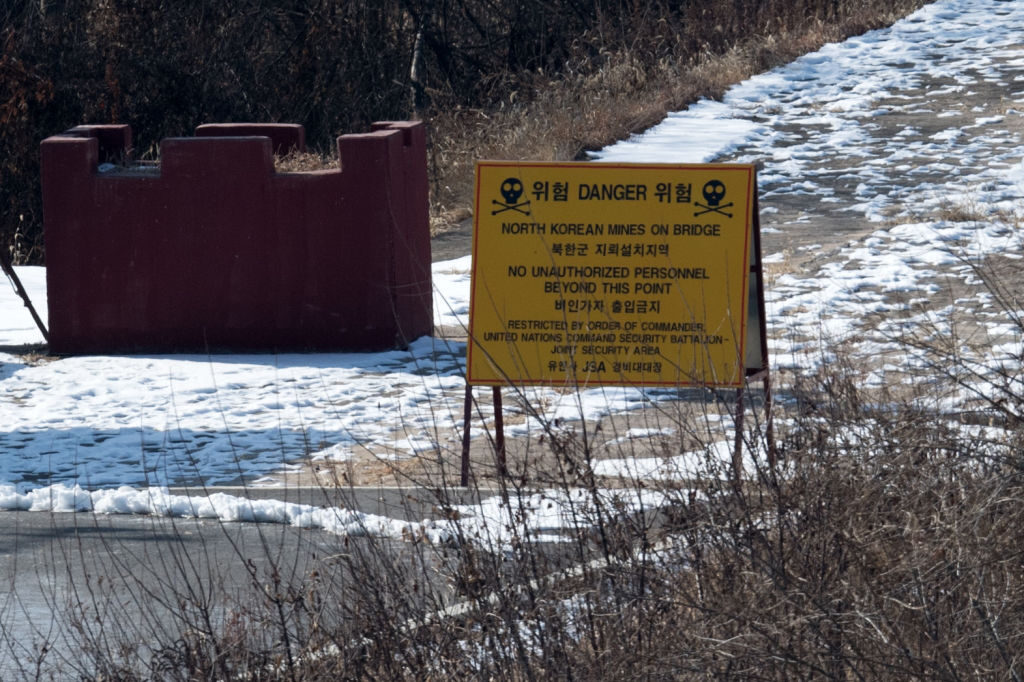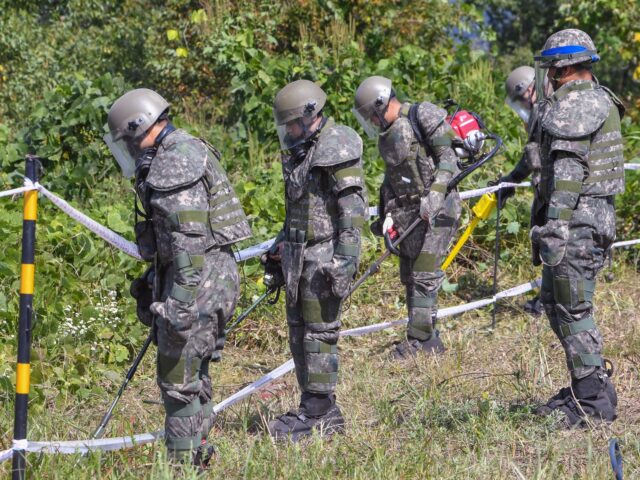Officials with the South Korean military confirmed on Monday that communist North Korea had littered roads between North and South Korea with landmines and begun taking down streetlights installed on them.
Officials with the South Korean Joint Chiefs of Staff (JCS), the military leadership in Seoul, told reporters that they had detected North Korean soldiers installing landmines on inter-Korean roads in late 2023. The roads are within the Demilitarized Zone (DMZ), the buffer region between the two Koreas created by the armistice that halted Korean War hostilities in 1953. As neither side has signed a peace agreement nor surrendered, the Korean War technically remains in vigor.
Shutting down avenues to facilitate travel between the two countries is the latest in a series of increasingly belligerent moves by the communist regime of dictator Kim Jong-un in the past year, the most menacing of which was Kim’s declaration in January that he would no longer pursue the unification of the Korean peninsula. North Korea had for decades refused to acknowledge the sovereignty of South Korea, describing it in state media as a territory legitimately belonging to a unified Korea under Pyongyang. Kim changed that precedent in January, declaring South Korea an enemy state.
“It is the final conclusion drawn from the bitter history of the inter-Korean relations that we cannot go along the road of national restoration and reunification together,” he said at the time.
Since then, North Korea has engaged in multiple threatening acts including allegedly developing an alleged “underwater nuclear weapon system” and conducting a simulated nuclear strike this month.

File/A sign warns of North Korean landmines on a bridge crossing between North and South Korea in the Demilitarized Zone (DMZ) between South and North Korea on February 7, 2018 in Panmunjom, South Korea. (Carl Court/Getty Images)
“The military detected the North laying mines on the unpaved road inside the DMZ late last year near Arrowhead Hill in Cheorwon, 85 kilometers northeast of Seoul,” the South Korean Yonhap News Agency reported. “Since late last year, the North has installed mines on all roads between the two Koreas once seen as symbols of inter-Korean reconciliation and cooperation.”
The roads that North Korea is targeting are all, Yonhap explained, linked to past failed initiatives to ease tensions between the two Koreas. The Cheorwon road, for example, was built during the administration of leftist former South Korean President Moon Jae-in, who pursued a policy of placating Pyongyang and signed agreements in 2018 to improve interconnectivity across the border.
Moon Jae-in made history in 2018 by visiting North Korea, the first time since 2007 that a South Korean president did so. Kim Jong-un honored the leftist president with a parade, a hug, and a visit to Mount Paektu, an active volcano of great spiritual significance in Korean culture. Moon’s diplomacy resulted in the establishment of a “joint liaison office” that year meant to ease communication and strength the ties between the two countries, hopefully paving the way for a formal end to the Korean War.
Moon never succeeded in ending the war. North Korea bombed the joint liaison office in 2020 and has largely returned to its policy of threatening nuclear attacks on the South consistently since Moon left office in 2022. Kim Jong-un never stopped showing Moon personal respect, however, sending him a goodbye letter after his term ended in 2022 that North Korean state media claimed was “an expression of their deep trust” between the two leaders.
Kim has not pursued a similar friendship with Moon’s successor, Yoon Suk-yeol, a hardline conservative who has invested in improving ties with Washington and strengthening the South Korean military.
Military authorities on Monday identified two other roads on which North Korean soldiers had placed mines in the past year. All the roads are seldom used and linked to unity projects.
“Due to the [Wuhan coronavirus] pandemic, South Korean officials closed its joint liaison office in Kaesong in 2020, marking the last time the Gyeongui road was used,” the Korea JoongAng Daily, identifying two of the other mined roads, reported on Monday. “Since the failed 2019 Hanoi summit between North Korean leader Kim Jong-un and then-U.S. President Donald Trump, the Donghae road has remained unused.”
South Korea JCS spokesperson Col. Lee Sung-jun told reporters that Seoul would take “necessary” measures in response to the new landmines, without elaborating.
Mining the roads appears to be a message to South Korea that Kim Jong-un is not open to a return to diplomacy. Kim explicitly said so in January, declaring “the historic time has come at last when we should define as a state most hostile toward the Democratic People’s Republic of Korea the entity called the Republic of Korea (ROK).”
“The ROK scums are our principal enemy,” Kim declared.

File/A South Korean soldier removes landmines inside of the Demilitarized Zone (DMZ) on October 2, 2018 in Cheorwon, South Korea. (Song Kyung-Seok-Pool/Getty Images)
That month, North Korean state media claimed that the country had developed an “underwater nuclear weapon system ‘Haeil-5-23.'” It did not specify exactly what the system was or how it would function. It would be the first of several declarations of military might featuring alleged new technology. In March, Kim appeared in photos allegedly driving new armored vehicles. North Korean state media reported that the country was now producing “the most powerful tanks in the world” with “very excellent striking power and maneuverability.”
Last week, the state-run Korean Central News Agency (KCNA) announced that Kim personally led a “counterattack” nuclear drill simulating the nuclear bombing of an enemy.
“Expressing great satisfaction over the result of the drill, the respected Comrade Kim Jong Un appreciated the high hit and accuracy of the super-large multiple rocket launchers,” KCNA reported, “saying that he seemed to see the firing of a sniper’s rifle and that the Korean-style tactical nuclear strike means boasting of the formidable might, the most powerful in the world, have strictly prepared themselves to faithfully mobilize.”
Follow Frances Martel on Facebook and Twitter.

COMMENTS
Please let us know if you're having issues with commenting.